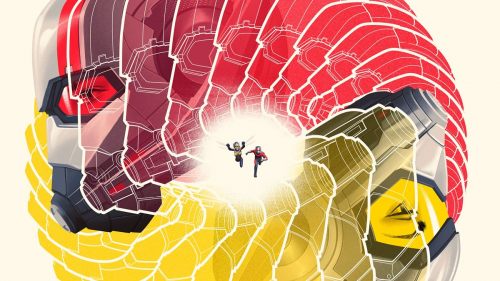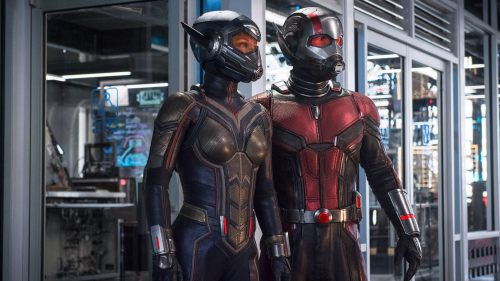Building A Colony: Unconventional Family Units In ANT-MAN AND THE WASP
Warning: spoilers for both Ant-Man movies below.
The first Ant-Man movie ended in a manner as delightful as the rest of the movie. Scott Lang (Paul Rudd), estranged from his ex-wife Maggie (Judy Greer) and daughter Cassie (Abby Ryder Fortson) thanks to his life of crime, rejoins his family - including his ex’s fiance Paxton (Bobby Cannavale) - for dinner. It’s an unassuming scene, but powerful in how good-natured it is. And Ant-Man and the Wasp only confirms that this sub-franchise is all about unconventional family units.
The Lang family - a mother, a daughter, a live-in stepdad, and an occasionally-present biological dad - is incredibly unusual by film standards. Movies tend to present non-nuclear families as an inherent negative. The “ex-wife’s new man,” especially, is often depicted as a villain to be ousted, the role of father a throne to be reclaimed. But Ant-Man finds a different path - one far more constructive for everyone involved. Scott Lang may be a cuck, as internet fuckboi invective would have it, but he’s a happy cuck, surrounded by a loving family where every member is content with the situation - not an ounce of toxic masculinity in sight. There are plenty of families like this around the world, and it’s remarkable how casually Ant-Man introduces this one.
Ant-Man and the Wasp starts with that unconventional family unit and builds an entire movie around it, thematically-speaking. Scott is even more physically removed from the family, thanks to an ankle bracelet trapping him at home (allegedly), but Cassie still visits regularly, and everybody’s understanding about the situation. Scott’s relationship with Cassie is core to the movie, with many of the best moments emerging from their interplay. His need to keep up appearances for the FBI, and by extension Maggie and Paxton, is the source of much excitement and laughter - he’s not trying to deceive them in a malevolent way, he just wants to keep the family together. And he manages to share some winking secrets with Cassie along the way. It’s adorable.
Across town, Hank Pym (Michael Douglas) and Hope van Dyne (Evangeline Lilly) have their own unique family unit. Hank’s been a solo dad since the disappearance of his wife Janet (Michelle Pfeiffer) into the subatomic Quantum Realm, and has achieved that in the only way he knows how: by inducting Hope into the family business of weird inventions. Despite (or perhaps because of) their regular clashing, it’s easy to view Scott as an adopted son to Hank - especially in the sequel, when his romance with Hope blossoms and the team-up truly becomes a family affair. Together, they work to find Janet and bring the Pym-van Dyne family back together - remarkably small stakes for a Marvel film, but stakes that genuinely mean something.

If the heroes’ aims are to reunite their families, the villains’ goals are to destroy them - in part due to losing their own. Nominal villain Ava Starr (Hannah John-Kamen), aka Ghost, isn’t out to conquer the world or destroy half of all life. She just wants to conquer her own quantum affliction, to ease the pain she lives with every day. To anyone with chronic illness, Ava’s goals are pretty relatable - especially when you factor in the loss of her family in the same accident that caused her quantum phasing. That she’s willing to sacrifice Janet van Dyne to achieve her goal is just a testament to her pain. It’s almost, but not quite, an addiction narrative: the temporary balm of her treatment chamber just isn’t enough, and Janet is a tool to achieve a better solution.
Ava's relationship with Bill Foster (Laurence Fishburne) factors into this too. Though the connection between the two is moderatley undercooked, mostly explored in a mid-film monologue, their relationship is yet another example of an unconventional family. Foster (I mean...his literal name is Foster) takes Ava in after the accident, caring for her partially out of guilt and partially out of a sense of paternal duty. This odd duo appears to have been in place for decades, continuing to search for a solution. It’s a one-sided relationship, but an intriguing one nonetheless.
Ant-Man and the Wasp’s ending suggests Ava may even get added to the Pym / Van Dyne / Lang extended family in the future (provided the characters don't remain Infinity-dust). Not only does Janet use her newfound Quantum Realm mojo to grant Ava a new lease on life; the post-credits scene implies the whole crew is trying to find her a more permanent cure. One assumes that such a cure would allow Ava complete control over her quantum state - eliminating her ability entirely wouldn’t make for exciting sequel fodder, after all - and allow her to join the team. I, for one, would be into that - Hannah John-Kamen smashed it in this film, and I hope to see her return.
It’s fitting that the Ant-Man movies exhibit such unique and comfortable approaches to their family units. Ant colonies themselves operate as a bizarre sort of hive-mind family unit that can expand, unnervingly, to cover hundreds of kilometres and billions of ants. Their hive-mind mentality makes them programmable for Hank, sure, but given the importance of family to these movies, it’s easy to see why they're so central. They represent a flawlessly operational, sprawling familial unit working as a team - exactly what the heroes in these films keep trying to build. (Hey, it's a valid reading - the first time we see Scott and Cassie, they're literally inside a cardboard model of an ant colony.)
These films are refreshing in their scale: like their heroes, the stakes are small and personal. Rather than saving the world, they’re movies about saving individuals and families. We could use more of that in the Marvel universe - movies whose action and threats are personal, rather than galactic.



